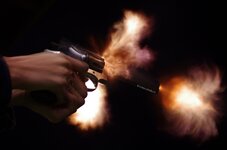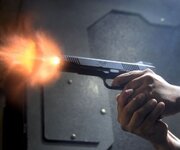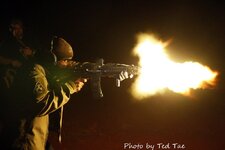Let's not forget last year. At least here in Wash. state. When the forest got good and dried out, the DNR called a shooting ban on state lands due to fire danger. I've been out on DNR land twice the past couple of weeks. Even with a day of rain between, it's pretty dry out there already and it's not quite May. So plan ahead, if you have the ammo to spare, anyway. Get your shooting sessions planned early if you can. Experimental loads, chronograph, etc., get it done early. I have an idea we might be in for another dry year and the state lands may once again be closed to shooting.
Navigation
Install the NWFA app
How to install the app on iOS
Follow along with the video below to see how to install our site as a web app on your home screen.
Note: This feature may not be available in some browsers.
More Options
You are using an outdated browser
The browser you are using is likely incompatible with our website. We recommend upgrading your current browser or installing an alternative.
JavaScript is disabled
Our website requires JavaScript to function properly. For a better experience, please enable JavaScript in your browser settings before proceeding.
-
Join the #1 community for gun owners of the Northwest
We believe the 2nd Amendment is best defended through grass-roots organization, education, and advocacy centered around individual gun owners. It is our mission to encourage, organize, and support these efforts throughout Oregon, Washington, Idaho, Montana, and Wyoming.Free Membership Benefits
- Fewer banner ads
- Buy, sell, and trade in our classified section
- Discuss firearms and all aspects of firearm ownership
- Join others in organizing against anti-gun legislation
- Find nearby gun shops, ranges, training, and other resources
- Discover free outdoor shooting areas
- Stay up to date on firearm-related events
- Share photos and video with other members
- ...and much more!
Staff Member
Gold Supporter
Bronze Lifetime
- Messages
- 23,294
- Reactions
- 111,614
For those that shoot muzzle loaders with a patch and ball....
Be sure to keep an eye out for a smoldering patch after shooting.
I have never seen a fire started this way with a smoldering patch...but I also don't want to be the first guy to start a fire that way either....
Andy
Be sure to keep an eye out for a smoldering patch after shooting.
I have never seen a fire started this way with a smoldering patch...but I also don't want to be the first guy to start a fire that way either....
Andy
Curious how centerfire or rimfire can cause a forest fire.
Shooting steel near dry grass or brush.
Bronze Supporter
- Messages
- 37,256
- Reactions
- 128,539
I'm married and I do what I want, when I want!! 
Yeah, yeah….. I know.

Yeah, yeah….. I know.
Yep. You can have sex whenever she wants.I'm married and I do what I want, when I want!!
Yeah, yeah….. I know.
Member 34319
- Messages
- 17,146
- Reactions
- 37,067
When I lived in Reno. With a mag of tracers and a steel plate at 200 yards. Let's just say I hadn't ran that fast since my years playing soccer.
ALWAYS KEEP A FIRE EXTINGUISHER
ALWAYS KEEP A SMALL SHOVEL
These two things can really save your arse. Last thing you want is to be responsible for a forest fire.
Have them at the shooting line, not in your car.
Be safe, have fun.
ALWAYS KEEP A FIRE EXTINGUISHER
ALWAYS KEEP A SMALL SHOVEL
These two things can really save your arse. Last thing you want is to be responsible for a forest fire.
Have them at the shooting line, not in your car.
Be safe, have fun.
- Messages
- 2,157
- Reactions
- 2,608
Curious how centerfire or rimfire can cause a forest fire.
I've seen a fire start when shooting into a debris covered berm with .223. I figured the bullet must have stopped near something dry and ready to burn. Quick and easy to put out, but had we not been paying attention, that probably wouldn't have been the case for much longer.
Member 34319
- Messages
- 17,146
- Reactions
- 37,067
Friction.Curious how centerfire or rimfire can cause a forest fire.
Metal pushed through metal at very fast speeds, creates a ton of friction.
Ever seen a Demoranch video where he always picks up the bullets he finds and immediately does the hot potato shuffle?
If you ever want to test it out. Get a piece of firewood. Shoot one mag into it. Split it. You'll see smoldering.
Shoot at places like the NWFC areas correctly, it shouldn't be much of an issue as the backstops are designed to be fire resistant. Shoot into nothing but trees as your backstop, it may or may not happen. All it takes is the right conditions to allow that smoldering to turn into something worse.
Silver Lifetime
- Messages
- 42,702
- Reactions
- 110,889
When I lived in Reno. With a mag of tracers and a steel plate at 200 yards. Let's just say I hadn't ran that fast since my years playing soccer.
ALWAYS KEEP A FIRE EXTINGUISHER
ALWAYS KEEP A SMALL SHOVEL
These two things can really save your arse. Last thing you want is to be responsible for a forest fire.
Have them at the shooting line, not in your car.
Be safe, have fun.
Went on a shoot on private land once back in the late 80s (IIRC) over by Royal City in eastern WA. Hot and dry (middle of summer), sagebrush. We were shooting into a hill that was about 500' high as a backstop. We had a metal plate up on the hill about 1KM away. Some of the guys started shooting tracers as it started to get dark - quite the show. Then it started a fire. The best way to get to the fire involved driving about a mile away to get to a road up on the hill. There was some scrambling and it took about an hour but they got the fire out. We could just imagine the headlines if the fire had spread. After that, no more tracers.
Silver Lifetime
- Messages
- 42,702
- Reactions
- 110,889
Friction.
Metal pushed through metal at very fast speeds, creates a ton of friction.
Ever seen a Demoranch video where he always picks up the bullets he finds and immediately does the hot potato shuffle?
If you ever want to test it out. Get a piece of firewood. Shoot one mag into it. Split it. You'll see smoldering.
Shoot at places like the NWFC areas correctly, it shouldn't be much of an issue as the backstops are designed to be fire resistant. Shoot into nothing but trees as your backstop, it may or may not happen. All it takes is the right conditions to allow that smoldering to turn into something worse.
Especially stumps (or dead trees) which are rotten - they dry out and catch fire easily. I had several stumps catch fire from embers put off by my slash piles. Several of them burned for weeks. One I kept having to dump water on for several days because it kept erupting in open flame.
We started burning just after the rain stopped about this time in 2019 - the ground was muddy enough to get tracked vehicles stuck if we weren't careful, and the slash piles still wet enough that it took an hour to get them going with flares and propane torches. Within three days we had to stop burning because embers flying thru the air would spread into surrounding grass/fuel and it was getting dangerous. So I called a halt. There are still about a dozen piles that we didn't get to burn.
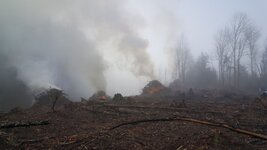
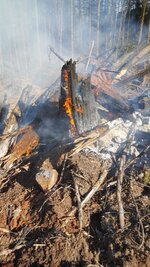
- Messages
- 2,770
- Reactions
- 5,926
I had a large fir stump that had been dug out and placed on a burn pile, and we lit the pile in October, after the Western Oregon rains had begun. The pile burned down completely, except for a quarter ton of stump. All was good, but the next June we smelled smoke in the area. Following the smell, we found that the stump was still burning, with no visible smoke.
We doused the small flame with water and all was well again. A few weeks later, now in fire season, we again smelled smoke. It was the same stump again! l brought in my small excavator with a thumb and moved the stump so we could dig out underneath it, and found several places where roots and sticks were burning underground. We used the fire truck to wet everything down again, and the fire did not reoccur.
We doused the small flame with water and all was well again. A few weeks later, now in fire season, we again smelled smoke. It was the same stump again! l brought in my small excavator with a thumb and moved the stump so we could dig out underneath it, and found several places where roots and sticks were burning underground. We used the fire truck to wet everything down again, and the fire did not reoccur.
Silver Lifetime
- Messages
- 42,702
- Reactions
- 110,889
I had a large fir stump that had been dug out and placed on a burn pile, and we lit the pile in October, after the Western Oregon rains had begun. The pile burned down completely, except for a quarter ton of stump. All was good, but the next June we smelled smoke in the area. Following the smell, we found that the stump was still burning, with no visible smoke.
We doused the small flame with water and all was well again. A few weeks later, now in fire season, we again smelled smoke. It was the same stump again! l brought in my small excavator with a thumb and moved the stump so we could dig out underneath it, and found several places where roots and sticks were burning underground. We used the fire truck to wet everything down again, and the fire did not reoccur.
Yes - this is common. Stumps can and will burn down into the roots, especially if the stump is not new and wet. Neighbor had some of his slash piles that were on top of a stump and had fires erupt (sometimes smoke) months later. I spent the better part of a month pouring water on my slash piles in 2019, every morning and evening. Any place there was smoke I poured water. I was glad when it was over - never want to do that again without the proper equipment (excavator and water truck).
I have a guy coming in the future to grind down some stumps from thinning in 2014.
- Messages
- 2,770
- Reactions
- 5,926
Note that the stump in question was not still rooted, it had been dug out and was on top of the pile!
Rooted stumps do burn down into the soil, and the extensive root system can burn for a long time.
Rooted stumps do burn down into the soil, and the extensive root system can burn for a long time.
Silver Lifetime
- Messages
- 42,702
- Reactions
- 110,889
It's not just shooting of course - that can cause fires - so be careful in general. Burning yard waste, fireworks, etc., even mowing can have a steel blade hit a rock and cause a spark (it seems every year this happens, usually in a farmer's grain field). operating equipment without a spark arrestor or some idiot parking in dry grass and having their cat convertor set it off.
Last September it was some idiot down the road who didn't put out their campfire properly - they never should have had the campfire to start with.
I was able to burn my burn pile after the recent rain, and right now it is misty out - so, at least here where I am at, fire danger is lower. But still, be careful - remember the year where we had the fire at 36 pit? Remember the fire from "target shooting" in Utah?
 www.oregon.gov
www.oregon.gov
Last September it was some idiot down the road who didn't put out their campfire properly - they never should have had the campfire to start with.
I was able to burn my burn pile after the recent rain, and right now it is misty out - so, at least here where I am at, fire danger is lower. But still, be careful - remember the year where we had the fire at 36 pit? Remember the fire from "target shooting" in Utah?
Oregon Department of Forestry : Target shooting : Recreation : State of Oregon
While shooting activity is permitted on state forestlands, ODF does not maintain any designated shooting areas.
Staff Member
Gold Supporter
Bronze Lifetime
- Messages
- 23,294
- Reactions
- 111,614
Hot brass can also start a grass / brush fire...seen that more than once while in the Army.
With that said...
I get that the amount of brass and or firearms used may be different than what is normally seen or used...
Still , it is something to consider.
Andy
With that said...
I get that the amount of brass and or firearms used may be different than what is normally seen or used...
Still , it is something to consider.
Andy
- Messages
- 982
- Reactions
- 2,691
Good Thread! There are countless ways to start fired when shooting (I've seen a lot of them!)
It's not just shooting steel.
Pick up a round that has just been fired. It's hot!
Shooting into wood can cause the material to ignite. Same with grass.
Never shoot into a tree!
Sparks can also be caused by rounds ricocheting off rocks.
As other members have pointed out hot brass has started more than one fire.
Even non-firearm related activities need special care. Are you parked over leaves or dry grass? Mufflers can cause them to ignite.
And lord knows how many careless cigarettes have caused fires.
Enjoy the outdoors. Shoot and have fun. But keep a good head on your shoulders so that the next generation can enjoy our beautiful wildlands.
It's not just shooting steel.
Pick up a round that has just been fired. It's hot!
Shooting into wood can cause the material to ignite. Same with grass.
Never shoot into a tree!
Sparks can also be caused by rounds ricocheting off rocks.
As other members have pointed out hot brass has started more than one fire.
Even non-firearm related activities need special care. Are you parked over leaves or dry grass? Mufflers can cause them to ignite.
And lord knows how many careless cigarettes have caused fires.
Enjoy the outdoors. Shoot and have fun. But keep a good head on your shoulders so that the next generation can enjoy our beautiful wildlands.
(...)
One I kept having to dump water on for several days because it kept erupting in open flame.
(...)
You sure it wasn't trying to talk to you? I mean, the last guy to listen to a burning bush kinda changed the world, so...?
Share This Discussion
Similar threads
- Replies
- 35
- Views
- 808
- Replies
- 19
- Views
- 630
Upcoming Events
New Classified Ads
-
Promoted Radian Model 1 11.5 build. For Trade/Sale
- Started by MrChunkyMonkey
- Replies: 0
-
-
-
-
Handcrafted Leather Wallets. Made to Last from Full Grain Cowhide. Great Price. $20 to $50
- Started by ddjchemist
- Replies: 0
-
-
-
-
-
Support Our Community
If our Supporting Vendors don't have what you're looking for, use these links before making a purchase and we will receive a small percentage of the sale






